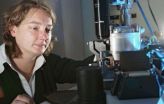Thought to be the first system of its kind in the world, it works by measuring and analysing the acoustic behaviour of soil to establish when a landslide is imminent so preventative action can be taken.
Noise created by movement under the surface builds to a crescendo as the slope becomes unstable and so gauging the increased rate of generated sound enables accurate prediction of a catastrophic soil collapse.
The technique has been developed by researchers at Loughborough University, in collaboration with the British Geological Survey, through two projects funded by the Engineering and Physical Sciences Research Council (EPSRC).
The detection system consists of a network of sensors buried across the hillside or embankment that presents a risk of collapse. The sensors, acting as microphones in the subsoil, record the acoustic activity of the soil across the slope and each transmits a signal to a central computer for analysis.
Noise rates, created by inter-particle friction, are proportional to rates of soil movement and so increased acoustic emissions mean a slope is closer to failure. Once a certain noise rate is recorded, the system can send a warning, via a text message, to the authorities responsible for safety in the area. An early warning allows them to evacuate an area, close transport routes that cross the slope or carry out works to stabilise the soil.
Neil Dixon, professor of geotechnical engineering at Loughborough University and principal investigator on the project, explains how the system – thought to be a global first – works. "In just the same way as bending a stick creates cracking noises that build up until it snaps, so the movement of soil before a landslide creates increasing rates of noise," said Professor Dixon.
"This has been known since the 1960s, but what we have been able to do that is new is capture and process this information so as to quantify the link between noise and soil displacement rates as it happens, in real time – and hence provide an early warning," he added.
The system is now being developed further to produce low cost, self-contained sensors that do not require a central computer. This work, which is being carried out under the second project funded by EPSRC, is focused on manufacture of very low cost sensors with integrated visual and/or audible alarms, for use in developing countries. Ongoing work includes field trials, market research and planning commercial exploitation of the technology.
"The development of low cost independent acoustic slope sensors has only become possible in very recent times due to the availability of microprocessors that are fast, small and cheap enough for this task," says Dixon.
As well as the life-saving implications for countries prone to disastrous landslides, the technique can also be used in monitoring the condition of potentially unstable slopes built to support transport infrastructure, such as rail and road embankments, in developed countries such as the UK.
Current development work is being funded through Loughborough University's knowledge transfer account, a fund supplied by EPSRC to help commercial exploitation of inventions arising from its research projects. A commercially available Alarms sensor is expected to be launched in the next two years.
###
Notes for editors
The three and a half year-long project, entitled 'Assessment of Landslides Using an Acoustic Real-Time Monitoring System (Alarms)', began on 1 December 2005 and ended on 31 May 2009. Loughborough University received EPSRC funding of £73,861.
The follow on project, 'Alarms: Low Cost Sensor Development and Exploitation', began on 1 July 2009 and ended on 30 June 2010. Project partners Loughborough University and the British Geological Survey received £61,760 and £49,699, respectively, from the EPSRC.
Materials undergoing deformation underground create acoustic stress waves, known as acoustic emissions. Gathering data on the emissions will provide information on the presence and location of straining.
The project team's sensor, for which Loughborough University has submitted a patent application, was developed to capture these acoustic emissions below the surface. It consists of a piezo-electric transducer that sits on top of a steel tube, called a wave guide, buried in the slope. The transducer converts the energy in the acoustic emissions into an electrical signal which is recorded by computer.
The wave guide sits within a borehole filled with gravel which moves in response to any strain or deformation within the slope. Movement of the gravel creates noise which is transmitted to the surface, and the transducer, via the steel tube.
The length of the wave guide is determined by the distance of the unstable subsoil under the surface and so can be tens of metres long, if necessary.
Monitoring is conducted at frequencies too high for the human ear to detect, which ensures background noise does not lead to false alarms.
About EPSRC
The Engineering and Physical Sciences Research Council (EPSRC) is the UK's main agency for funding research in engineering and the physical sciences. EPSRC invests around £850m a year in research and postgraduate training, to help the nation handle the next generation of technological change.
The areas covered range from information technology to structural engineering, and mathematics to materials science. This research forms the basis for future economic development in the UK and improvements for everyone's health, lifestyle and culture. EPSRC also actively promotes public awareness of science and engineering. EPSRC works alongside other Research Councils with responsibility for other areas of research. The Research Councils work collectively on issues of common concern via Research Councils UK.
Loughborough University
Loughborough is one of the country's leading universities, with an international reputation for research that matters, excellence in teaching, strong links with industry, and unrivalled achievement in sport and its underpinning academic disciplines. www.lboro.ac.uk/
The British Geological Survey
The British Geological Survey (BGS), a component body of the Natural Environment Research Council (NERC), is the nation's principal supplier of objective, impartial and up-to-date geological expertise and information for decision making for governmental, commercial and individual users.
The BGS maintains and develops the nation's understanding of its geology to improve policy making, enhance national wealth and reduce risk. It also collaborates with the national and international scientific community in carrying out research in strategic areas, including energy and natural resources, our vulnerability to environmental change and hazards, and our general knowledge of the Earth system. More about the BGS can be found at www.bgs.ac.uk.
For more information contact:
Professor Neil Dixon, e-mail: n.dixon@lboro.ac.uk, tel: 01509 228542
Images are available from the EPSRC Press Office. Contact tel: 01793 444404, e-mail: pressoffice@epsrc.ac.uk
Image details and suggested captions:
Systemdiagram.jpg: A diagram of the acoustic monitoring system
Field trial.jpg: The field trial of the new system showing the acoustic monitoring taking place
END




